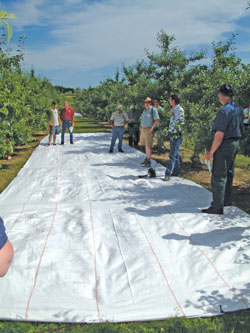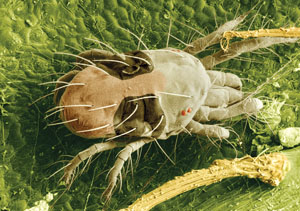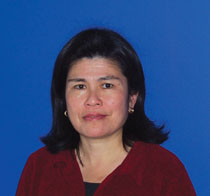
Features
Production
Research
Maritime-based apple researchers
examining the use of reflective mulch
March 6, 2008 By Dan Woolley
Agriculture and Agri-Food Canada’s
Atlantic Food and Horticultural Research Centre (AFHRC) is putting
apple orchard management under the microscope with several research
trials examining disease, insect and weed control.
 |
| Researchers with Agriculture and Agri-Food Canada are examining the use of reflective mulch, similar to the type demonstrated at the Simcoe Research Station in Ontario Photos courtesy of Margaret Land and USDA-ARS |
Agriculture and Agri-Food Canada’s Atlantic Food and Horticultural Research Centre (AFHRC) is putting apple orchard management under the microscope with several research trials examining disease, insect and weed control.
Apple scab
For AAFC researcher Dr. Gordon Braun, the biggest disease threat facing Annapolis Valley orchards is apple scab. His plot of organically certified Macintosh and Cortland, located at the AFHRC orchard in Kentville, N.S., experienced heavy apple scab pressure during the 2007 growing season. The Annapolis Valley had about 16 danger periods for scab infection from mid-April until the end of July, he explained.
Weather played a definite role in Dr. Braun’s research woes. A very wet Nova Scotia growing season meant many of his organic scab controls – which included lime-sulphur, sulphur and copper – were washed from the orchard foliage by rain. Despite the setbacks, results were observed in some trials.
 |
| in Atlantic apple orchards plus investigating new production practices to combat two-spotted spider mite Photos courtesy of Margaret Land and USDA-ARS |
With lime-sulphur, a very high ratio can still be active 60 hours following application, said Dr. Braun, although he adds the product must be sprayed on dry foliage. When using straight sulphur, he advises avoiding application with oil or when there is a risk of frost. Dr. Braun warns growers to be extra cautious when applying copper since it can cause russeting and phytotoxicity issues. It can also accumulate in orchard soils and kill beneficial earthworms.
“There is some risk we might lose (registration for copper sprays) here,” he said, adding the European market does not
accept their use.
Ultimately, Dr. Braun admits the development of scab resistant cultivars may be the best solution for battling apple scab in Nova Scotia. A lot of research into cultivar resistance to disease and insects has been done in the province and AFHRC has created two resistant varieties – Nova Mac and Nova Spy. Unfortunately, they are hard to sell to consumers because the public doesn’t recognize the varieties.
Spider mite
Fellow AAFC research scientist Dr. Mike Hardman is also involved in developing improved orchard management protocols. He is examining the effect an orchard’s herbicide strip width might have on two-spotted spider mite populations.
Dr. Hardman has found that the wider an orchard’s herbicide strip, the more spider mites are present. This is due, in part, to several factors.
First, predator mites, the natural controllers of spider mite populations, have great difficulty crossing wide herbicide strips, he said, adding in many cases, the predator mites drown in them when it rains and avoid them during hot and dry soil conditions.
“They don’t like to cross,” said Dr. Hardman.
Second, the number of spider mite eggs increases as the herbicide strip becomes wider, thereby increasing the number of spider mites to a point where they can overwhelm the ability of existing predator mites to control their numbers.
Narrow herbicide strips are known for resulting in lower incidence of fire blight in an orchard and result in decreased populations of white-banded leaf roller and aphids, said Dr. Hardman, adding narrow strips can also result in increased plant competition for the tree, meaning decreased access to plant nutrients and stunted tree growth.
As part of his research, Dr. Hardman is investigating the use of different grass varieties – such as Kentucky bluegrass, bentgrass and fescue – to influence spider mite populations. He is particularly interested in Muhlenbergia, a grass that has been found to be inhospitable to pests, and Nimblewell, a grass that U.S. researchers have determined does not host nematodes or mites. It is also tolerant to drought and is short growing, meaning less nutrient competition for the orchard trees, said Dr. Hardman.

|
| Dr. Julia Reekie |
Plastic mulch
In 2006, Dr. Julia Reekie started her trials investigating plastic mulch as a means of controlling weeds and insects, conserving soil moisture and increasing the skin colour of apples. She installed white, reflective mulch in an organic block of Liberty in early August 2006. The fruit was harvested eight weeks later during October.
From that trial, Dr. Reekie examined 960 apples from 12 treated (reflective mulch) and 12 control trees (no reflective mulch). She found that fruit harvested from trees where the reflective mulch was used had 90 per cent red and 10 per cent green colouring. This compared to 75 per cent red and 25 per cent green colouring on the fruit where no reflective mulch was used in the orchard.
Dr. Reekie expanded her research trials during the 2007 season to include an examination of what role the reflective mulch can play in maximizing photosynthesis. In light of this, the mulch was applied in early May. Photo diodes were installed within the orchard to monitor the quantity of light entering the tree canopy while sensors were used to measure the amount of sap flow within the trees.
Dr. Reekie plans to collect the data covering tree growth, leaf changes and fruit yield at the end of the growing season and analyze the results over the winter.
The plastic mulch used during the trials was sourced from New Zealand. The fabric is very durable and can be driven over by a tractor, according to Dr. Reekie, who added the product is expected to last for five seasons. The mulch measures four metres wide, comes in a roll length of 100 metres and sells for about $374 per roll with an additional $100 in costs for fittings and ground anchorage.
Dr. Reekie hopes to extend her plastic mulch research trial in 2008 to include use in a block of organic Honeycrisp. ❦
|
Varied rootstocks lead to varied
management, yield
Nova Scotia apple producer John Eisses isn’t afraid to experiment in his Annapolis Valley orchard
Currently, the replant project is close to completion with a little over an acre of the old varieties remaining. Eisses’ new apple cultivars include Honeycrisp, Ambrosia, Early Fuji and Nova Spy. Eisses’ Honeycrisp plantings are grafted on several different rootstocks, including Malling (M) 7, Budagovsky (Bud) 9, Malling (M) 26, Cornell-Geneva (CG) 30 and Malling-Merton (MM) 106. The varied rootstocks have resulted in varied results. While one three-year-old block of Honeycrisp on M.26 rootstock yielded 600 bushels per acre, a second block, planted on M.7 rootstock and utilizing a high trellis system, has yielded between 1,200 and 1,600 bushels per acre. The rootstocks have also resulted in varied orchard management requirements. Eisses quickly discovered that thinning Honeycrisp on CG.30 rootstock is challenging while the same cultivar on M.7, planted in five-foot by 14-foot spacing is a “good combination. “We have had good results on (MM) 106 as well,” said Eisses. “But I feel it will be a challenge in pruning.” Tree vigour and growth has also been varied. A small block of Honeycrisp planted on M.26 in 2006 is not coming along as quickly as Eisses would like. He has also planted Ambrosia, a B.C. variety, in his new orchard, planting his block four years ago on M.9 Nic® 29 rootstock at a spacing of three-foot by 14-foot spacing. The block yielded him 800 bushels per acre in its third year. “They aren’t large apples and it is a challenge to maintain their size,” he said, adding the variety is very much like Gala and is not as vigorous as Honeycrisp. In the past two years, Eisses has planted additional blocks of Ambrosia using M.26 and Bud 9 rootstocks at a spacing of two feet by 12 feet. “Part of my thinking on smaller In the Annapolis Valley, Ambrosia harvest begins near the end of the Honey-crisp season. Mulch trial As an orchard mulch, straw degrades quickly, explained Scotian Gold Cooperative’s Larry Lutz. Growers are seeking a product that is permeable but still has some permanence that can be easily spread along the tree row. Enter two erosion-control products – Flexterra and Cocoflex. These two products are actually extracted from tree fibres and use a polymer as a binding agent. As part of the trial, a mulch of de-inked and de-watered paper was applied to the orchard row and the two products were hydro-seeded. As a comparison, the products were also sprayed directly on the soil in the tree rows. It’s anticipated the mulch will remain in the rows for two years. Commercial application of the two products is estimated to cost about nine cents per square foot, according to Dave Keays, a representative for the manufacturer, Profile Products LLC. ❦
|
Print this page